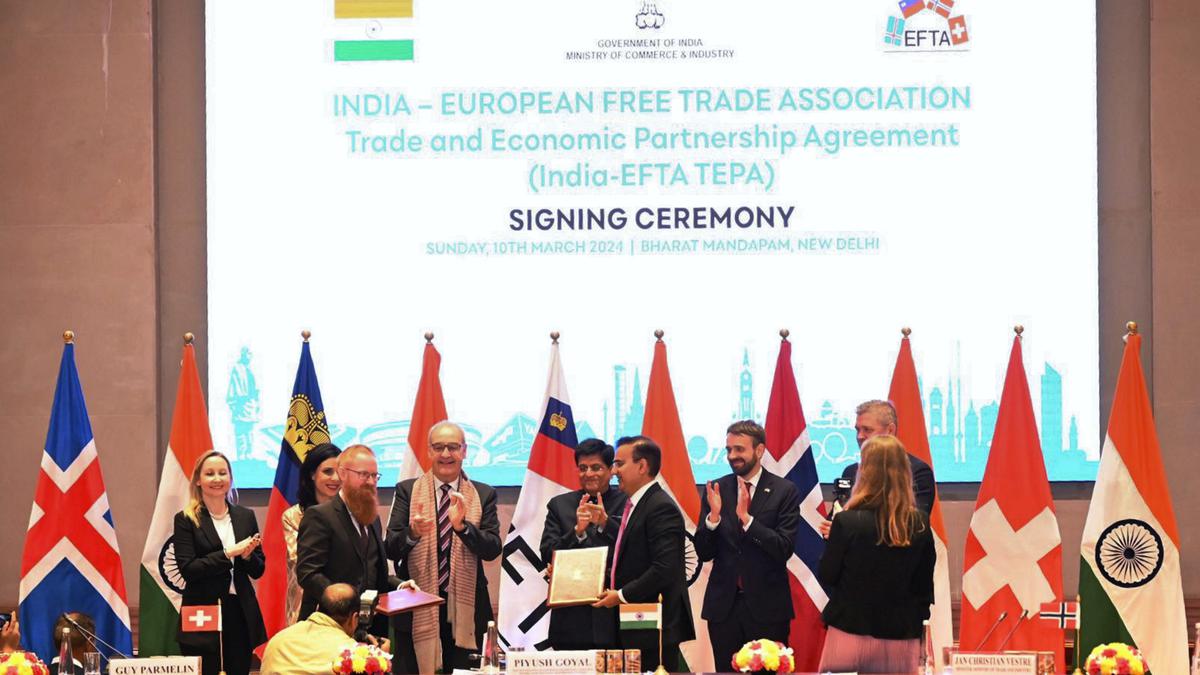
What do FTAs with European countries signal? | Explained
The Hindu
India-EFTA TEPA: A detailed analysis of the trade agreement's impact on investment, goods, services, sustainable development, and intellectual property rights.
The story so far:
The India-EFTA Trade and Economic Partnership Agreement (TEPA) is the latest in India’s recent Free Trade Agreements (FTAs). As its name suggests, the thrust of the FTA is deeper economic engagement with the EFTA ( European Free Trade Association) countries — Switzerland, Norway, Iceland and Liechtenstein. It heralds the westward tilt of India’s FTAs, being the first with any European country and the western world.
The successful conclusion of an FTA with developed countries including Switzerland and Norway is a significant positive signal to the world, showcasing India’s firm commitment to trade liberalisation at a time of rising protectionism across both developed and developing countries. For trading partners, an FTA with India is very attractive since it represents surpassing India’s high tariff walls to access a large market. The TEPA negotiations started almost 15 years back; however, these were rapidly concluded in the last few months, close on the heels of the swift conclusion of FTAs with Australia and the UAE. The FTAs with the U.K. and the EU are also reportedly at an advanced stage.
Investment: TEPA sets out a target of a $100 billion investment into India from EFTA countries, and consequent one million jobs over a 15-year period. It also provides India the ability to withdraw its tariff concessions if such expected investment is not achieved. A closer look at the legal text reveals that for the promised investments and jobs to materialise, two conditions need to be met: India growing at a fast rate of 9.5%, and the return on EFTA investments in India exceeding 16% annually over the 15-year timeline. If not, both sides may lower their level of ambitions. If India is not satisfied, it can pull back its tariff concessions in a proportionate manner after 18 years. The investment chapter is not subject to dispute resolution and is overall, a statement of positive intent, and its benefits will be dependent on the private sector’s responsiveness to the TEPA.
Trade in goods: the chief gain here is for EFTA’s market, which can have more access to India due to tariff concessions. India is mandated to eliminate tariff on most products within seven to 10 years. This will benefit EFTA exports of seafood like tuna and salmon, fruits like olives and avocados, coffee capsules, oils like cod liver and olive oil, and a variety of sweets and processed foods including chocolate and biscuits. Also covered are smartphones, bicycle parts, medical equipment, clocks, and watches, many medicines, dyes, textiles, apparels, iron and steel products, and most machinery. Additionally, tariffs on cut and polished diamonds will be reduced from 5% to 2.5% in five years. For wines, India has extended tariff cuts as follows: wines priced between $5 and less than $15 will see a duty reduction from 150% to 100% in the first year, which will then decrease gradually to 50% over 10 years. For wines costing $15 or more, the initial duty cut is from 150% to 75%, eventually reducing to 25% after 10 years.
Gold, which accounts for 80% of the merchandise imports from EFTA countries, as well as dairy, soya, coal and some sensitive agricultural products have been excluded from India’s tariff concession list.
With regard to India’s exports to EFTA, there will be no material impact since most products face very low or zero tariff for nations which have the Most Favoured Nation (MFN) status in EFTA countries. For example, value wise, 98% of India’s $1.3 billion merchandise exports to Switzerland are industrial products where tariff is already zero. The remaining 2% of India’s exports are agricultural products, where gains would be negligible due to low trade values.





















 Run 3 Space | Play Space Running Game
Run 3 Space | Play Space Running Game Traffic Jam 3D | Online Racing Game
Traffic Jam 3D | Online Racing Game Duck Hunt | Play Old Classic Game
Duck Hunt | Play Old Classic Game











